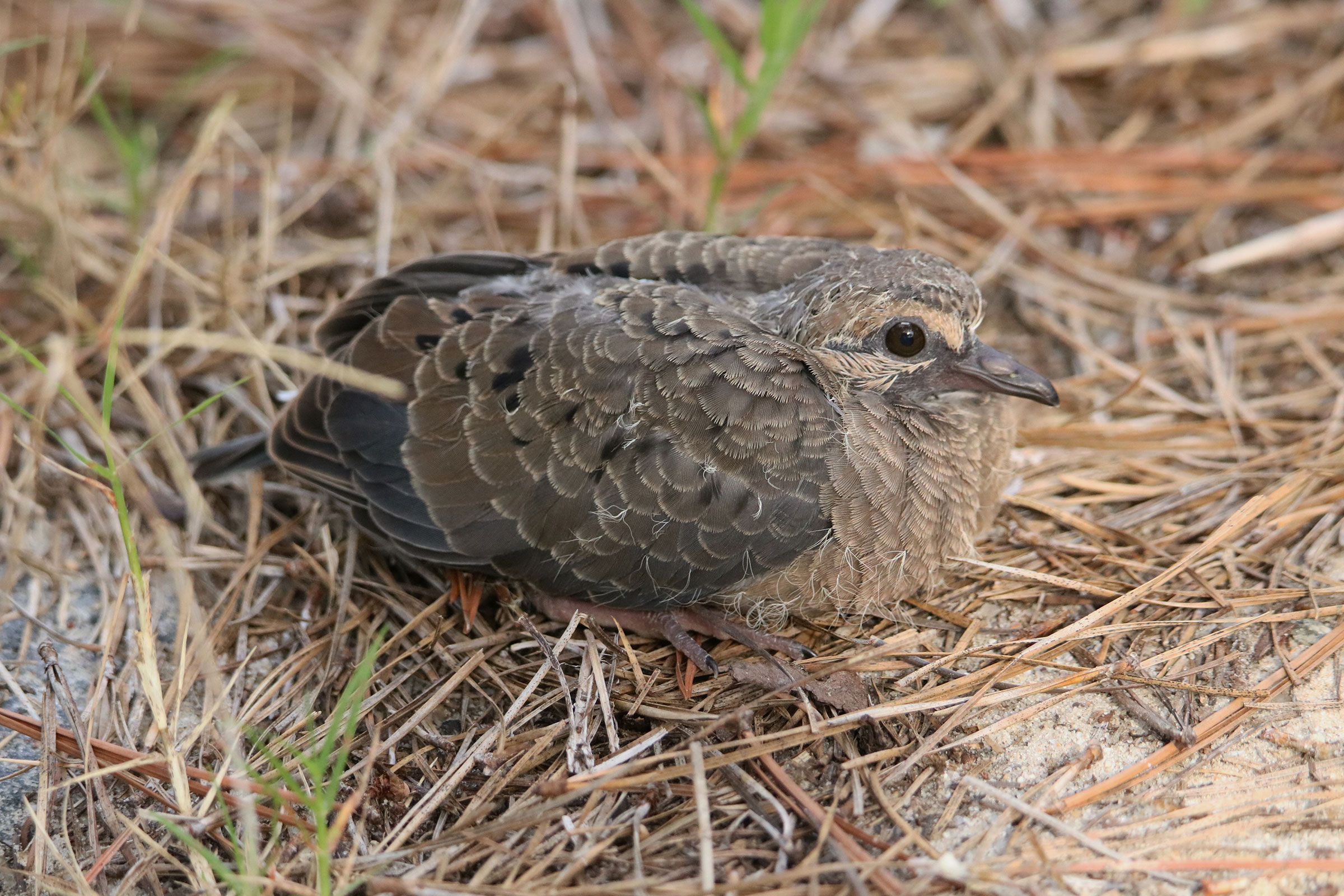Introduction
The Mourning Dove’s melancholy coo-OO-oo is one of the most recognizable and nostalgic sounds signaling the start of a Virginia summer. It has reddish feet, a small and rounded head, and casual gray-brown plumage. Mourning Doves are common but much-appreciated visitors to bird feeders, backyards, farms, and city parks. When startled, the species’ wings make a distinct sound to signal danger to its flock mates (Otis et al. 2020).
Despite the species’ year-round presence in Virginia, some Mourning Doves are migratory. Most doves banded in Virginia are recovered within the state, but out-of-state recoveries have come from neighboring states in the southeast and as far south as Florida (Lewis 2024).
Breeding Distribution
One of the most abundant birds in Virginia (and North America), the Mourning Dove is nearly ubiquitous throughout the state (Figure 1). The only areas where this species is slightly less likely to occur are some high-elevation forested areas in the Mountains and Valleys region and coastal margins. Its likelihood of occurrence is strongly associated with forest edge habitat, lending to its familiarity in fragmented, suburban habitats.
In the time since the First Atlas (Figure 2), the Mourning Dove’s likelihood of occurrence remained nearly constant statewide, with some small areas of potential increase at elevation in the Mountains and Valleys region (Figure 3). Historically rare at higher elevations in winter (Rottenborn and Brinkley 2007), this increase may signal an increasing winter presence in warmer temperatures.

Figure 1: Mourning Dove breeding distribution based on probability of occurrence (Second Atlas, 2016–2020). This map indicates the probability that this species will occur in an Atlas block (an approximately 10 mi2 [26 km2] survey unit) based on environmental (including habitat) factors and after adjusting for the probability of detection (variation in survey effort among blocks).

Figure 2: Mourning Dove breeding distribution based on probability of occurrence (First Atlas, 1985–1989). This map indicates the probability that this species will occur in an Atlas block (an approximately 10 mi2 [26 km2] survey unit) based on environmental (including habitat) factors and after adjusting for the probability of detection (variation in survey effort among blocks). Blocks in white were not surveyed during the First Atlas and were not modeled.
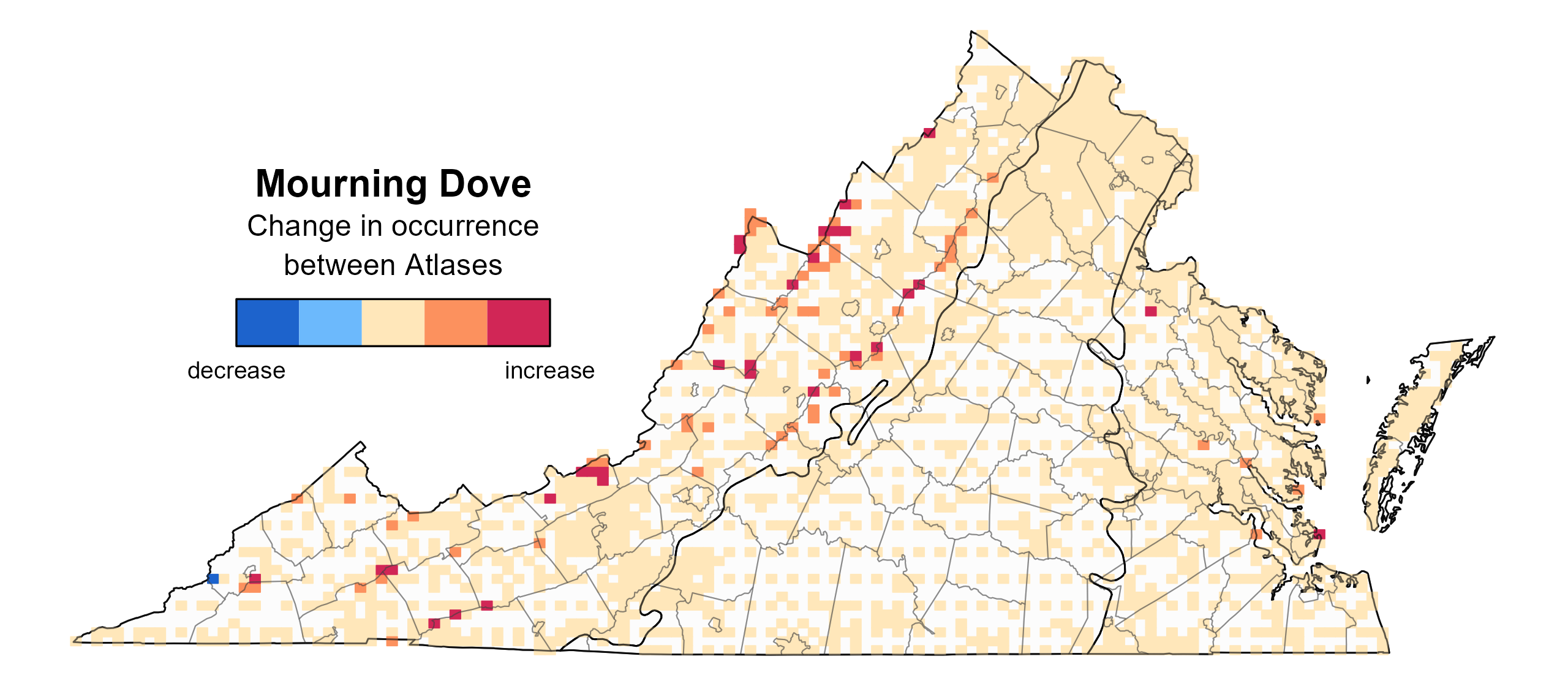
Figure 3: Mourning Dove change in breeding distribution between Atlases (1985–1989 and 2016–2020) based on probability of occurrence. This map indicates the change in the probability that this species will occur in a block (an approximately 10 mi2 [26 km2] survey unit) between Atlas periods. Blocks with no change (tan) may have constant presence or constant absence. Blocks in white were not surveyed during the First Atlas and were not modeled.
Breeding Evidence
Mourning Doves were confirmed breeders in 612 blocks and 117 counties and found to be probable breeders in an additional seven counties (Figure 4). They were considered at least probable breeders in every county in the state, a distinction shared by few species. Breeding was confirmed statewide during the First Atlas as well (Figure 5).
Mourning Doves bred over an extended season, spanning nine months of the year. The earliest documentation of breeding was February 15 when adults were observed carrying nesting material (Figure 6). Although all breeding behaviors except carrying a fecal sac were recorded, breeding evidence was primarily documented through observations of recently fledged young, occupied nests, and adults carrying nesting material. Recently fledged young were observed as late as October 25.
For more general information on the breeding habits of this species, please refer to All About Birds.
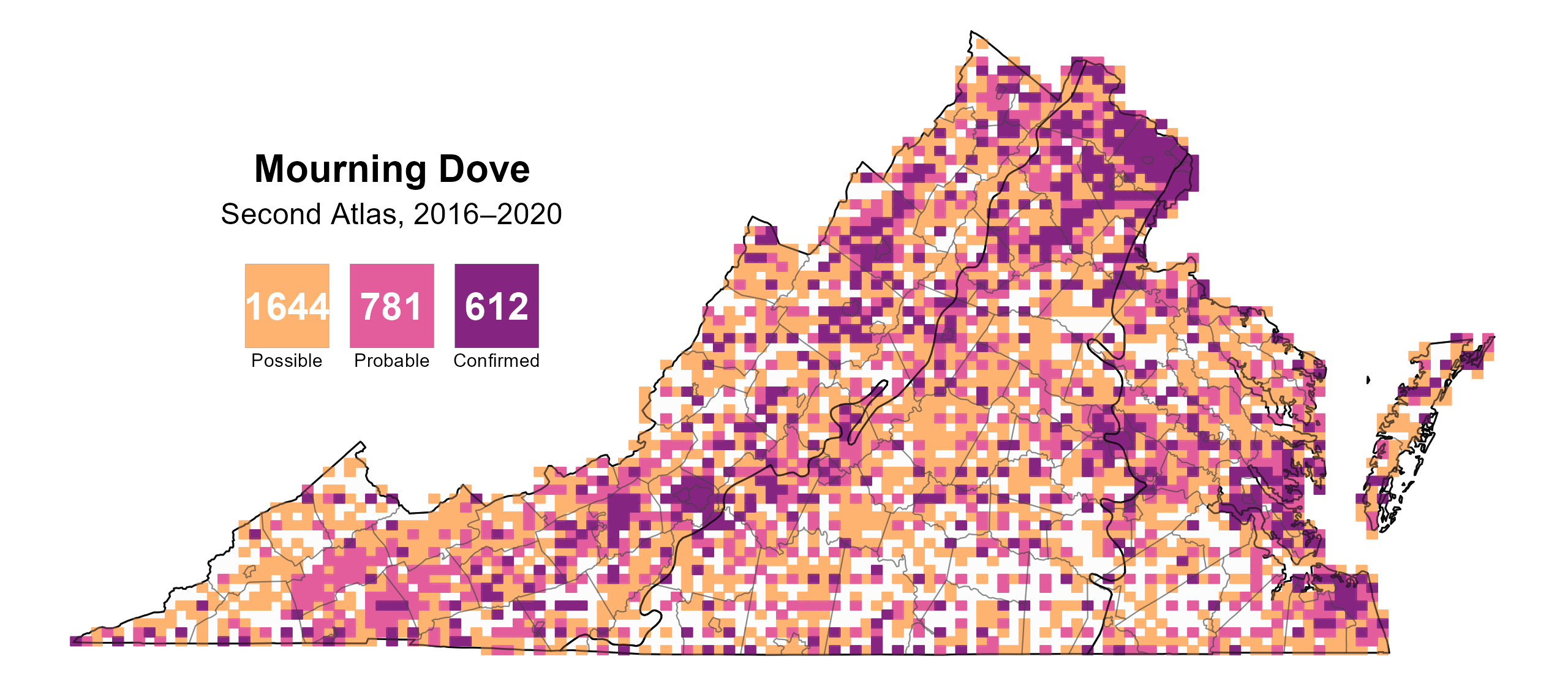
Figure 4: Mourning Dove breeding observations from the Second Atlas (2016–2020). The colored boxes illustrate Atlas blocks (approximately 10 mi2 [26 km2] survey units) where the species was detected. The colors show the highest breeding category recorded in a block. The numbers within the colors in the legend correspond to the number of blocks with that breeding evidence category.

Figure 5: Mourning Dove breeding observations from the First Atlas (1985–1989). The colored boxes illustrate Atlas blocks (approximately 10 mi2 [26 km2] survey units) where the species was detected. The colors show the highest breeding category recorded in a block. The numbers within the colors in the legend correspond to the number of blocks with that breeding evidence category.

Figure 6: Mourning Dove phenology: confirmed breeding codes. This graph shows a timeline of confirmed breeding behaviors. Tick marks represent individual observations of the behavior.
Population Status
Mourning Dove relative abundance was estimated to be highest in Virginia’s agricultural valleys and throughout urban, suburban, and rural Northern Virginia. Abundance was generally high throughout the state, except in heavily forested and high-elevation areas (Figure 7).
The total estimated Mourning Dove population in the state is approximately 1,348,000 individuals (with a range between 1,094,000 and 1,666,000). Based on data from the North American Breeding Bird Survey (BBS) from 1966–2022, the Mourning Dove population remained relatively stable in Virginia, with a nonsignificant decline of 0.17% annually. The trend between Atlases was similar, with a nonsignificant decrease of 0.16% per year from 1987–2018 (Hostetler et al. 2023; Figure 7).
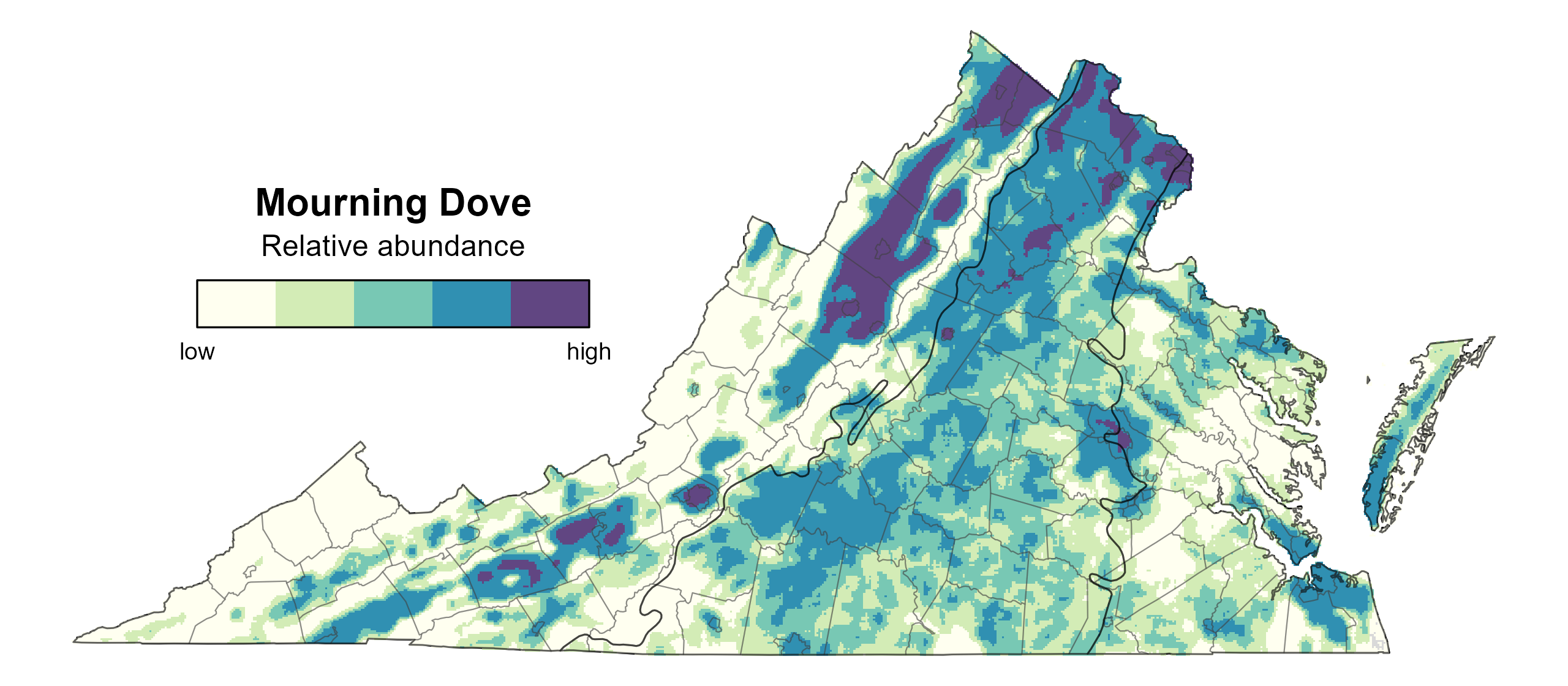
Figure 7: Mourning Dove relative abundance (Second Atlas, 2016–2020). This map indicates the predicted abundance of this species at a 0.4 mi2 (1 km2) scale based on environmental (including habitat) factors. Abundance values are presented on a relative scale of low to high.
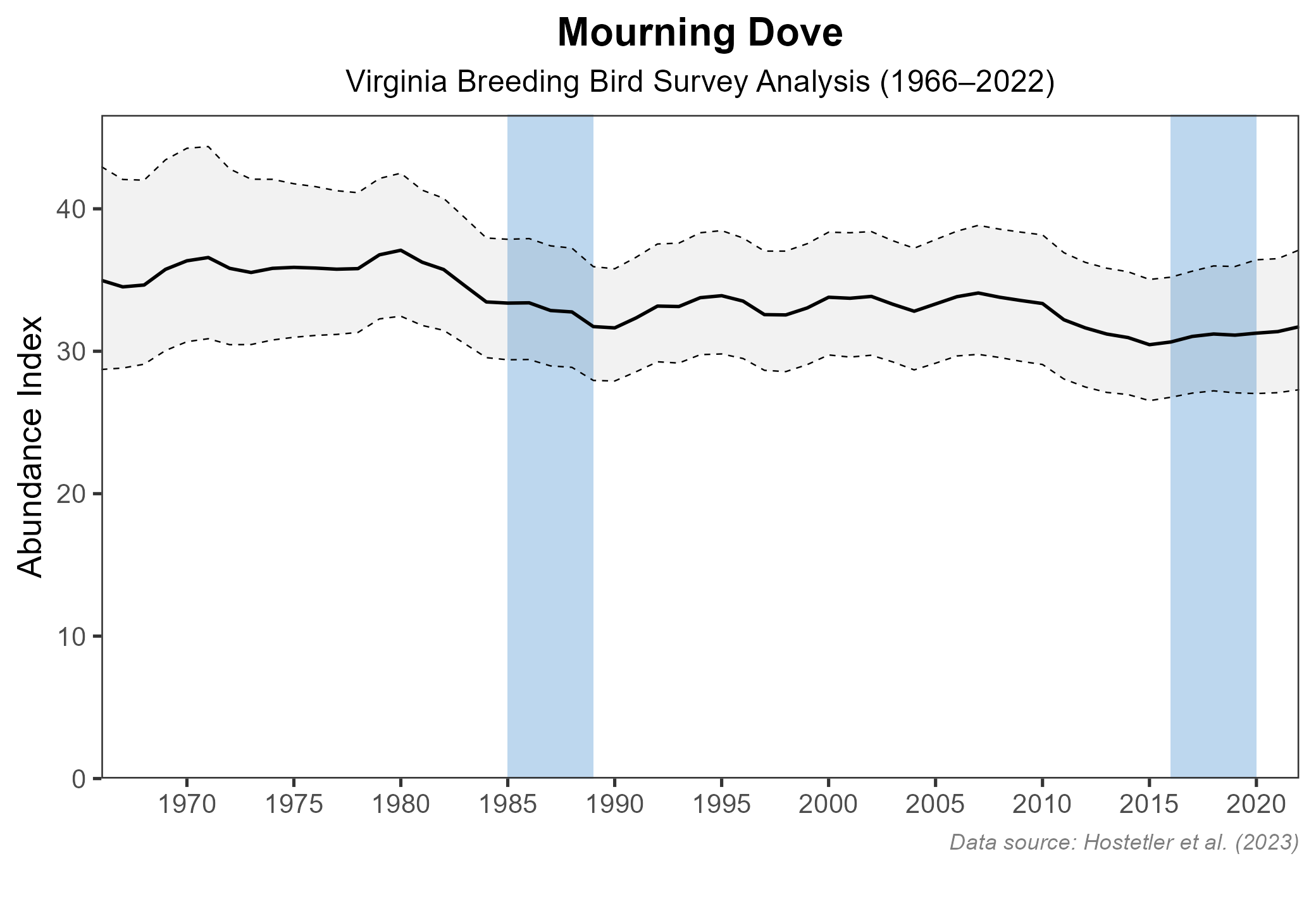
Figure 8: Mourning Dove population trend for Virginia as estimated by the North American Breeding Bird Survey. The vertical axis shows species abundance; the horizontal axis shows the year. The solid line indicates the estimated population trend; there is a 97.5% probability that the true population trend falls between the dashed lines. The shaded bars indicate the First and Second Atlas periods.
Conservation
Mourning Dove populations are generally stable throughout their range, and the species is not considered to be of conservation concern. In Virginia and many other states, the Mourning Dove is a popular upland gamebird. Each year, hunting license sales in Virginia produce millions of dollars in conservation funding that supports Mourning Doves and a range of other wildlife species.
Interactive Map
The interactive map contains up to six Atlas layers (probability of occurrence for the First and Second Atlases, change in probability of occurrence between Atlases, breeding evidence for the First and Second Atlases, and abundance for the Second Atlas) that can be viewed one at a time. To view an Atlas map layer, mouse over the layer box in the upper left. County lines and physiographic regional boundaries (Mountains and Valleys, Piedmont, and Coastal Plain) can be turned on and off by checking or unchecking the box below the layer box. Within the map window, users can hover on a block to see its value for each layer and pan and zoom to see roads, towns, and other features of interest that are visible beneath a selected layer.
View Interactive Map in Full Screen
References
Hostetler, J. A., J. R. Sauer, J. E. Hines, D. Ziolkowski, and M. Lutmerding (2023). The North American breeding bird survey, analysis results 1966–2022. U.S. Geological Survey, Laurel, MD, USA. https://doi.org/10.5066/P9SC7T11.
Lewis, B. (2024). Virginia dove hunting forecast for the 2024-2025 season. Virginia Department of Wildlife Resources Blog. https://dwr.virginia.gov/blog/virginia-dove-hunting-forecast/.
Otis, D. L., J. H. Schulz, D. Miller, R. E. Mirarchi, and T. S. Baskett (2020). Mourning Dove (Zenaida macroura), version 1.0. In Birds of the World (A. F. Poole, Editor). Cornell Lab of Ornithology, Ithaca, NY, USA. https://doi.org/10.2173/bow.moudov.01.
Rottenborn, S. C., and E. S. Brinkley (Editors) (2007). Virginia’s birdlife: An annotated checklist. 4th edition. Virginia Society of Ornithology.





